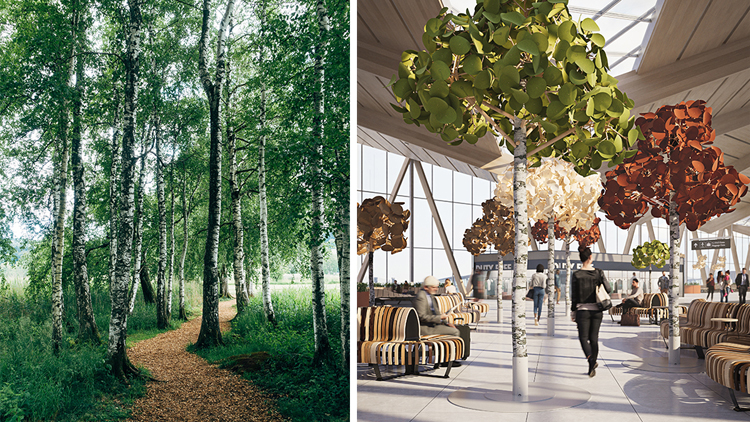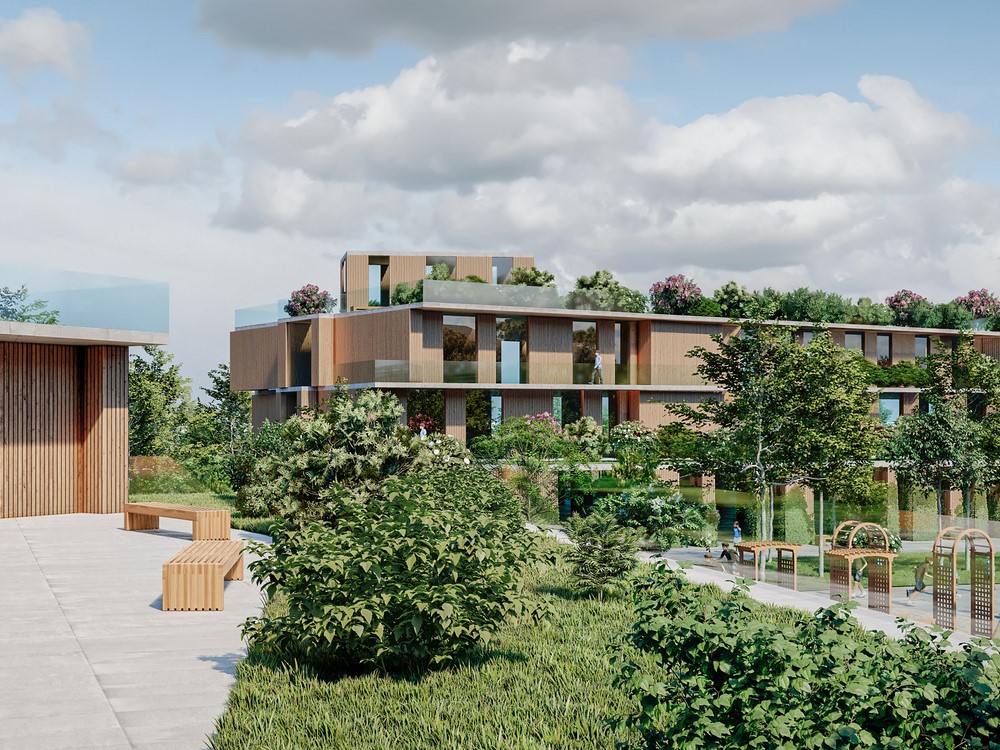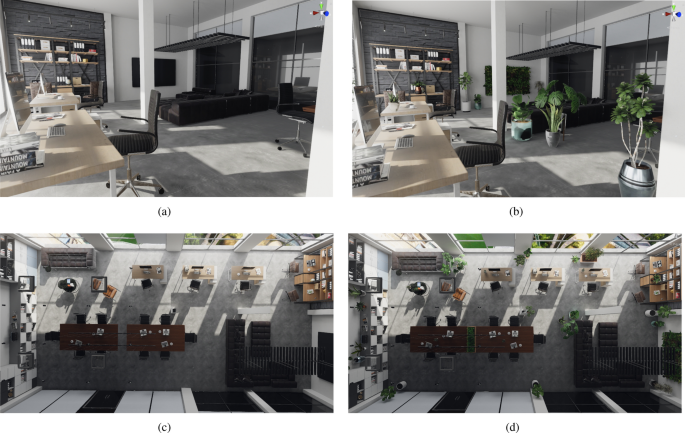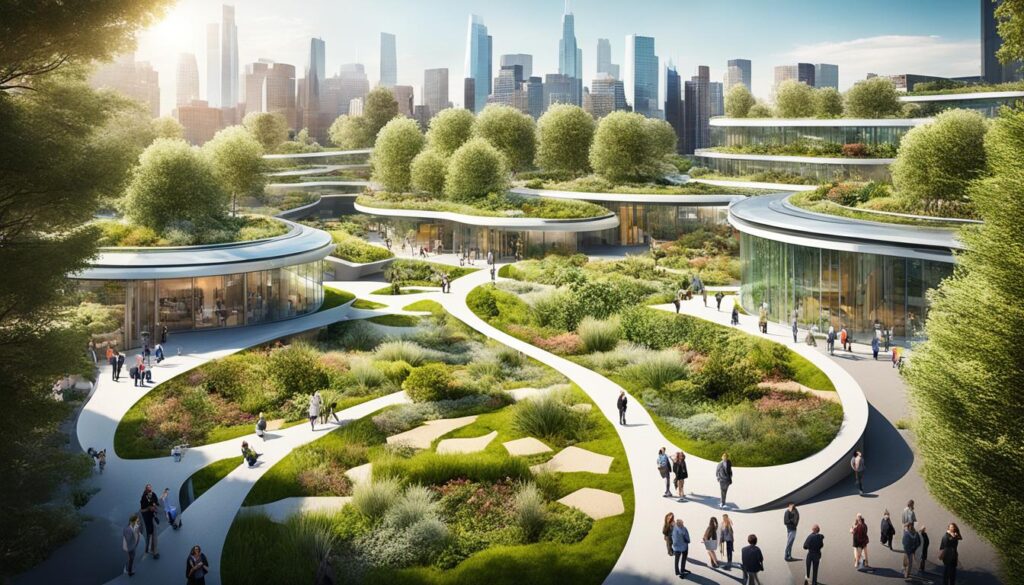Breakthroughs in Biophilic Urban Furniture Design.
In contemporary urban environments, the integration of nature into design has become increasingly essential. Biophilic urban furniture design aims to bridge the divide between dynamic city life and the natural world, thereby enhancing daily experiences for residents and visitors alike.
This article examines the concept of biophilic design, its significance, and the principles that govern its implementation. By improving mental health and fostering community interaction, these innovative designs hold the potential to transform urban spaces and cultivate a more harmonious relationship with nature.
What Is Biophilic Urban Furniture Design in the Context of Urban Planning?
.jpg_00.jpeg)
Biophilic urban furniture design represents an innovative methodology that incorporates natural elements into urban infrastructure, thereby enhancing user experience in outdoor spaces and promoting sustainability. This approach is deeply rooted in urban planning and landscape architecture, showcasing a commitment to green infrastructure and human-centered design.
This design philosophy aims to establish a connection between individuals and nature through the utilization of sustainable materials, resulting in functional and aesthetically pleasing furniture that aligns with the principles of green architecture and eco-friendly furniture design.
By stressing the importance of nature integration within urban landscapes, biophilic design supports urban biodiversity and improves the ecological impact of community spaces, ultimately contributing to the development of healthier and more vibrant urban environments.
Why Is Biophilic Urban Furniture Design Important?
Biophilic urban furniture design plays a vital role in promoting well-being and enhancing the health benefits associated with outdoor living in urban settings. This design approach fosters psychological connections to nature while actively contributing to urban sustainability through the integration of natural elements that enhance air quality and mitigate the urban heat island effect.
By prioritizing user-oriented spaces that facilitate social interaction and community engagement, biophilic design supports urban resilience and fosters the development of restorative environments that benefit individuals of all ages.
What Are the Principles of Biophilic Design?
The principles of biophilic design encompass a variety of strategies that emphasize the integration of natural elements to foster spatial design harmony and enhance user experience, contributing to urban resilience and ecological sustainability.
By prioritizing interaction with nature, these principles promote sensory engagement and emotional well-being, resulting in environments that align with human-centered design philosophies and nature-inspired design.
The application of these principles in urban furniture design not only enhances the aesthetic appeal of spaces but also promotes functionality and comfort, ensuring that designs address the diverse needs and preferences of users.
1. Connection to Nature and Urban Biodiversity
The connection to nature is a fundamental principle of biophilic design, highlighting the significance of nature immersion in enhancing human well-being and emotional health within urban ecosystems. This principle advocates for the integration of natural elements in community spaces, thereby promoting restorative environments that foster social interaction and connectivity among residents.
Incorporating greenery, water features, and natural light into urban settings encourages individuals to engage with the outdoors, creating opportunities for increased community involvement and social bonding. These green spaces not only provide a respite from the fast-paced urban lifestyle but also invite residents to convene, collaborate, and share experiences.
The psychological advantages of spending time in nature, such as reduced stress levels and improved mood, play a vital role in enhancing overall quality of life. Promoting these connections fosters a sense of responsibility toward the environment, ultimately supporting ecological health and sustainability within the community.
2. Natural Shapes and Forms
Natural shapes and forms play a crucial role in biophilic design, as they reflect the aesthetics of nature and enhance the appeal of urban furniture. This principle promotes design innovation aimed at creating versatile, adaptable, and modular solutions that improve functionality while maintaining a strong connection to the natural environment.
By thoughtfully incorporating organic contours and textures, designers can cultivate a more inviting atmosphere that aligns with users’ preferences and encourages social interaction. Furniture that seamlessly adapts to various spaces and activities not only addresses practical needs but also enriches the visual experience within urban environments.
The true value of such designs lies in their capacity to harmonize functionality with artistic expression, ensuring that each piece serves a distinct purpose while reflecting the calming qualities of nature. This connection to natural elements fosters well-being, resulting in spaces that are more vibrant and engaging for all users.
3. Natural Materials
The utilization of natural materials is fundamental in biophilic design, as it fosters sustainability and promotes innovation in materials within urban infrastructure. By selecting renewable resources that minimize ecological impact, designers can create furniture that enhances the visual appeal of outdoor spaces while simultaneously promoting environmental health and resilience.
Incorporating elements such as reclaimed wood, bamboo, and recycled metals not only introduces an organic aesthetic but also aligns with the increasing demand for eco-conscious solutions in urban environments. These selections reflect a commitment to sustainability, fostering a deeper connection between individuals and their surroundings.
By prioritizing materials that are both functional and visually appealing, urban furniture has the potential to transform public spaces into inviting areas that encourage social interaction, relaxation, and well-being, ultimately contributing to healthier urban ecosystems. Such innovation not only drives aesthetic advancements but also inspires communities to engage more meaningfully with their environment.
4. Natural Light and Airflow
.jpg_01.jpeg)
Natural light and airflow are essential components of biophilic design, playing a significant role in urban comfort and enhancing the health benefits associated with outdoor spaces. By prioritizing climate-responsive design strategies that optimize natural lighting and air circulation, urban furniture can facilitate the creation of wellness-oriented environments that improve air quality and promote emotional well-being.
Design professionals are increasingly recognizing the value of incorporating elements such as shade structures and strategically positioned seating to maximize sunlight exposure while ensuring adequate airflow. These design features not only enhance the aesthetic appeal of public spaces but also improve user experiences by providing areas conducive to relaxation and social interaction.
The effective integration of natural light and ventilation serves to mitigate heat and reduce reliance on artificial cooling solutions, thereby promoting sustainability. Ultimately, prioritizing these factors contributes to the development of inviting outdoor spaces that foster a sense of community and well-being, making urban areas more livable for all individuals.
What Are the Benefits of Biophilic Urban Furniture Design for Community Health and Well-being?
Biophilic urban furniture design presents a wide array of benefits that substantially enhance both mental and physical health, while promoting social interaction and community engagement within urban spaces.
By incorporating natural elements into urban settings, this design approach significantly boosts productivity and creativity, enabling residents to flourish in restorative environments that alleviate stress and anxiety.
Additionally, the integration of biophilic principles in urban design fosters inclusivity and connectivity, ensuring that public spaces are accessible and accommodating to the diverse needs of all users.
1. Improves Mental and Physical Health
Biophilic urban furniture design significantly enhances mental and physical health by promoting emotional well-being through increased interaction with nature and the creation of restorative spaces. These environments encourage mindfulness and alleviate feelings of stress and anxiety, thereby contributing to the overall health benefits for users.
By incorporating elements of nature into urban landscapes, this design approach fosters deeper connections between individuals and their surroundings. Thoughtful arrangements of greenery, natural materials, and water features can evoke a sense of calm and tranquility, which is particularly essential in today’s fast-paced lifestyle.
Such restorative spaces encourage individuals to take moments for reflection, enabling them to recharge both emotionally and mentally.
Research indicates that regular interaction with natural elements can improve mood and enhance cognitive functions, ultimately leading to increased productivity and creativity. Therefore, adopting biophilic principles within urban environments transcends mere design choice; it represents a critical strategy for promoting holistic well-being.
2. Increases Productivity and Creativity
The integration of biophilic elements in urban furniture design has been demonstrated to enhance productivity and creativity among users, thereby improving the overall user experience. By developing multifunctional designs that resonate with natural aesthetics, urban planners can promote innovative thinking and engagement within public spaces.
This relationship arises from the intrinsic human connection to nature, which significantly contributes to mental well-being and focus. For example, the incorporation of natural materials, greenery, and water features into urban landscapes not only enhances visual appeal but also fosters social interactions, collaborative efforts, and community engagement.
When individuals engage with environments that emulate natural settings, they frequently experience reduced stress levels and improved moods. As a result, as individuals feel more relaxed and inspired, their creative capacities expand, leading to beneficial outcomes for both personal and professional pursuits. This form of nature therapy is integral to fostering well-being in urban spaces.
Establishing this synergy between nature and design is essential for nurturing vibrant urban communities and promoting urban resilience through adaptive reuse and sustainable materials.
3. Reduces Stress and Anxiety
Biophilic urban furniture design plays a significant role in reducing stress and anxiety by applying principles of environmental psychology and nature-inspired design to create restorative spaces that immerse users in natural elements. This immersion not only enhances emotional well-being but also promotes a sense of calm and relaxation within urban environments.
By incorporating natural elements such as plants, water features, and organic materials, these designs facilitate a profound connection between individuals and their surroundings, enhancing outdoor living experiences. Research indicates that exposure to nature can significantly lower cortisol levels, thereby improving mood and cognitive function.
The integration of green spaces within urban furniture not only encourages social interaction but also provides opportunities for personal reflection and community engagement. As individuals engage with these thoughtfully designed elements, they are able to rekindle their intrinsic connection to the natural world, which is essential for mental rejuvenation and overall psychological health. Such environments also play a critical role in urban ecology by supporting a diverse range of species and natural habitats.
4. Enhances Community Interaction
Biophilic urban furniture design significantly enhances community interaction by creating welcoming public spaces that promote social engagement and connection among residents. By incorporating elements that foster urban biodiversity and inclusive design, these spaces facilitate place-making and contribute to the development of vibrant communities that thrive on collaboration and interaction. This approach to urban planning helps create multifunctional furniture solutions that cater to diverse community needs.
The integration of natural materials and greenery into these designs not only enhances visual appeal but also supports local wildlife, thereby promoting a rich ecosystem that benefits both people and nature. Such environments encourage residents to gather, share experiences, and build relationships, thereby reinforcing the social fabric of neighborhoods. Green infrastructure like this is vital for promoting ecological sustainability and creating a sense of place within urban landscapes.
Adopting inclusive design principles ensures that individuals of all ages and abilities can comfortably interact with these spaces, fostering a sense of belonging and ownership. In essence, by nurturing both biodiversity and community connections, biophilic design plays a vital role in shaping dynamic and resilient urban environments. The emphasis on human-centered design and participatory design processes ensures that the needs of the community are at the forefront of development.
What Are Some Examples of Biophilic Urban Furniture Design?
.jpg_10.jpeg)
Examples of biophilic urban furniture design encompass innovative solutions, including green walls, natural material seating, and interactive water features that effectively integrate nature into urban environments. These examples of design innovation highlight the importance of sustainability and multifunctional furniture in creating adaptive and resilient spaces.
Furthermore, natural lighting fixtures are crucial in enhancing both the aesthetic appeal and functional aspects of community spaces, thereby promoting user well-being and comfort. These fixtures, which utilize climate-responsive design principles, contribute significantly to the ecological sustainability of urban areas.
1. Green Walls and Roofs
Green walls and roofs exemplify biophilic urban furniture design, offering crucial habitats for urban wildlife while enhancing urban biodiversity. These installations facilitate the integration of nature within urban environments and provide significant ecological benefits, such as improved air quality and a reduction in urban heat island effects.
By promoting a sustainable ecosystem in the urban landscape, these green structures not only support various species—such as birds, insects, and plants—but also deliver numerous environmental advantages. For example, they effectively reduce stormwater runoff, thereby mitigating flooding and promoting healthier water cycles. The presence of diverse flora can enhance pollination activities, fostering robust communities of pollinators that are essential for food production. This approach to urban planning is integral to creating restorative environments and improving air quality in cities.
Moreover, green walls and roofs contribute aesthetic value, creating tranquil spaces that can enhance mental well-being and encourage community interactions. This ultimately strengthens the connection between residents and their natural surroundings, fostering a sense of urban resilience through habitat creation and ecological sustainability.
2. Natural Material Seating
Natural material seating serves as a prime example of biophilic urban furniture design by utilizing sustainable materials that emphasize comfort and support furniture ergonomics. This user-centered design approach enhances the aesthetic appeal of outdoor spaces while also promoting prolonged use and enjoyment. By integrating natural materials, designers can create outdoor furniture that blends seamlessly with the landscape.
The integration of such seating options encourages individuals to connect more profoundly with their surroundings, thereby fostering a sense of well-being. By incorporating materials such as reclaimed wood, bamboo, and recycled metals, these designs not only minimize environmental impact but also cultivate a warm and inviting atmosphere. This practice of material innovation supports the principles of the circular economy and sustainable urbanism.
These deliberate material choices enhance the user experience by addressing both physical requirements—through supportive contours and cushioning—and emotional responses associated with natural aesthetics. Ultimately, the adoption of natural materials in seating solutions not only meets the increasing demand for sustainability but also encourages healthier interactions within communal environments. This approach to design aesthetics and furniture functionality ensures that urban spaces are both practical and beautiful.
3. Water Features
Water features in urban environments exemplify the principles of biophilic design by fostering sensory engagement and enhancing users’ immersion in nature. These installations create restorative spaces that significantly contribute to urban comfort while promoting emotional well-being and reducing stress. The use of water features also aids in urban heat mitigation, making cities more livable during hot seasons.
The presence of flowing water not only attracts visual attention but also offers soothing auditory experiences that effectively mask urban noise, resulting in environments that feel more tranquil and inviting. Such designs often encourage individuals to engage with their surroundings, thereby facilitating social connectivity and promoting outdoor activities. This multifunctional use of water features exemplifies the principles of integrated design and urban beautification.
By incorporating these features into urban furniture, designers create opportunities for reflection and mindfulness, allowing individuals to reconnect with nature amidst the demands of city life. Water features serve as a potent reminder of the natural world, ultimately enriching the user experience and fostering a healthier urban ecosystem. These sensory experiences are essential for promoting community health and well-being.
4. Natural Lighting Fixtures
Natural lighting fixtures are essential elements of biophilic urban furniture design, significantly enhancing visual appeal and promoting comfort in outdoor environments. These lighting solutions are integral to creating urban comfort and fostering outdoor interaction.
By incorporating climate-responsive design principles, these fixtures play a crucial role in the ecological sustainability of urban areas, fostering energy efficiency and overall well-being. Their design for longevity ensures that they remain functional and beneficial over time, contributing to the resilience of urban environments.
These fixtures utilize the power of sunlight to create warm and inviting atmospheres while minimizing dependence on artificial lighting, which can adversely affect both the environment and our sense of place. By leveraging passive design principles, these fixtures enhance the overall user experience and promote environmental sustainability.
This approach not only improves the aesthetic quality of parks, plazas, and streetscapes but also encourages social interaction among residents. By enhancing these outdoor spaces, natural lighting fixtures play a pivotal role in place-making and landscape architecture.
When strategically placed, these fixtures can maximize exposure to natural light throughout the day, thereby enhancing mood and productivity. This careful spatial design also contributes to the aesthetic harmony of urban areas, creating inviting and functional public spaces.
Engaging with such sustainable designs not only improves comfort but also cultivates a collective responsibility for preserving natural resources, ultimately contributing to the resilience of urban ecosystems. This focus on sustainability and social interaction is essential for promoting a vibrant urban lifestyle.
Frequently Asked Questions
Q1:
What is biophilic urban furniture design?
.jpg_11.jpeg)
Biophilic urban furniture design is a form of urban furniture that incorporates natural elements and living organisms into its design. This approach aims to create a more sustainable, functional, and aesthetically pleasing urban environment. By utilizing nature integration and eco-friendly furniture solutions, designers can enhance the quality of life in urban areas.
Q2:
What are the benefits of biophilic urban furniture design?
There are many benefits to using biophilic urban furniture design. It can improve air quality, reduce stress levels, increase biodiversity, and create a more harmonious and attractive urban landscape. Additionally, such designs can promote community health and well-being through enhanced nature connectivity and participatory design.
Q3:
What are some examples of breakthroughs in biophilic urban furniture design?
Some examples of breakthroughs in biophilic urban furniture design include living walls, green roofs, solar-powered benches, interactive sculptures, and natural material seating. These innovations demonstrate how multifunctional furniture can be both practical and sustainable, supporting environmental impact reduction and improved urban ecology.
Q4:
How does biophilic urban furniture design contribute to sustainability?
Biophilic urban furniture design helps to create a more sustainable urban environment by reducing carbon footprint, promoting biodiversity, and utilizing renewable energy sources. This approach to urban development emphasizes the importance of circular economy principles and climate-responsive design.
Q5:
What are some challenges in implementing biophilic urban furniture design?
Some challenges in implementing biophilic urban furniture design include cost, maintenance, and finding suitable locations for installation. There may also be resistance from traditional urban design practices. Addressing these challenges requires a focus on design equity and collaborative design processes that engage the community in decision-making.
Q6:
How can biophilic urban furniture design benefit communities and individuals?
Biophilic urban furniture design can benefit communities and individuals by providing a healthier and more enjoyable urban environment. It also promotes a connection to nature and encourages physical activity and social interaction. These health benefits are integral to creating sustainable and resilient urban lifestyles.

I’m Bruno, an architect with a deep passion for Biophilic Design in Urban Architecture. Throughout my career, I’ve focused on integrating natural elements into urban planning, and I created this site to share my insights and foster a deeper understanding of how biophilic principles can significantly enhance urban living. Dedicated to sustainable development, I continually explore innovative design solutions that promote both environmental and human well-being in city landscapes.














Publicar comentário